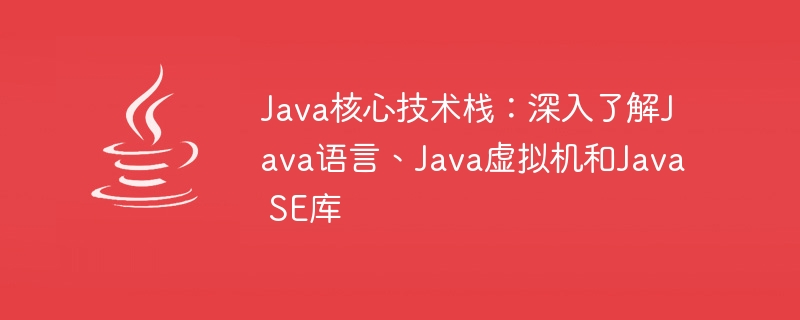

Java core technology stack: in-depth understanding of the Java language, Java virtual machine and Java SE library
With the continuous development of computer science and technology, the Java language has become the world's most popular language. One of the popular programming languages. As a cross-platform high-level programming language, Java is widely used in various fields, especially in enterprise-level application development and cloud computing. To become an excellent Java developer, you must be proficient in the core Java technology stack, namely the Java language, Java virtual machine, and Java SE library.
First of all, the Java language is the foundation of the Java core technology stack. The Java language is simple, object-oriented, portable, distributed, multi-threaded, and safe, allowing developers to write programs more efficiently. The syntax and features of the Java language are similar to C, but more concise and safe, making it easier for developers to understand and maintain. When learning the Java language, you need to master basic knowledge such as data types, variables, operators, control structures, arrays, classes and objects, as well as advanced features such as exception handling, input and output, multi-threading, and collection frameworks.
Secondly, the Java Virtual Machine (JVM) is a key part of the Java core technology stack. JVM is the environment in which Java programs run. It achieves cross-platform capabilities by translating Java bytecode into platform-specific machine code. The main functions of JVM include bytecode execution, garbage collection, memory management and thread management. Understanding the working principle of the JVM is very important for understanding the running mechanism and performance optimization of Java programs. When learning JVM, you need to understand components such as class loaders, bytecode execution engines, garbage collectors, and just-in-time compilers, and be able to use JVM tools for debugging and performance analysis.
Finally, the Java SE library is another important component of the Java core technology stack. The Java SE library contains a large number of classes and interfaces, providing a rich set of functions and methods for implementing various common tasks and functions. The core part of the Java SE library is the Java Standard Library, which includes the implementation of common functions such as input and output, network communication, multimedia processing, database connection, and graphical user interface. In addition, the Java SE library also includes Java collection framework, concurrency framework, XML processing, security and other modules, providing developers with a wealth of tools and frameworks to improve development efficiency and code quality.
When learning the core Java technology stack, we can conduct in-depth study and practice by reading relevant books and tutorials, participating in training courses, and completing actual projects and exercises. In addition, it is also very important to understand the latest developments and development trends in the Java community. You can obtain the latest technical information and experience sharing by participating in technical exchange meetings, following technical blogs and forums, etc.
To sum up, the Java core technology stack includes the Java language, Java virtual machine and Java SE library, which together form the cornerstone of the Java platform. Mastering these core technologies is very important to becoming an excellent Java developer. By having an in-depth understanding of the characteristics and mechanisms of the Java language, understanding the working principles and optimization techniques of the JVM, and becoming familiar with the common functions and frameworks of the Java SE library, you can improve the performance and reliability of your program, while also increasing your competitiveness and career development. prospect. Therefore, we should seize the opportunity to learn the core Java technology stack and continuously improve our technical level and practical capabilities.
The above is the detailed content of Core elements of Java technology: in-depth understanding of the Java language, Java virtual machine, and Java SE libraries. For more information, please follow other related articles on the PHP Chinese website!




